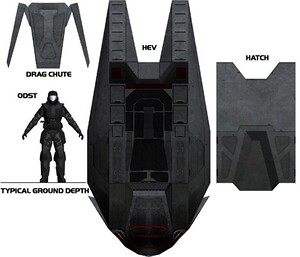Single Occupant Exoatmospheric Insertion Vehicle
From Halopedia, the Halo wiki
A Single Occupant Exoatmospheric Insertion Vehicle, also referred to as a Human Entry Vehicle or HEV, is a small pod used by the United Nations Space Command to deploy an individual from high orbit to the ground.
SOEIV usage is popularly associated with the men of the elite UNSC Marine Shock Troopers, although UNSC Special Forces operators are known to use these as one of their primary infiltration methods as well [1].
Operation
Doctrine
SOEIV's allowed for the rapid deployment of ground assault troops near or right onto an objective. Their smaller profiles made them more difficult to destroy by defensive fire than conventional dropships. The large number of pods dropped at once also increased the probability of some of the attack force surviving to the land. Each pod bore the name of the soldier inside; amongst other things this identification could be used to identify the unfortunate occupant of a destroyed pod.
ODST doctrine required the command unit of an SOEIV-facilitated assault to land first to minimize the period of disorder that might occur as pods landed and soldiers deployed. Command unit SOEIVs were equipped with additional features, including high-powered imaging gear and the Class C military AI (such as Wellsley [2]) required to operate it.
Reentry
An SOEIV slightly resembles a somewhat sleek teardrop and is made of Titanium-A, Lead Foil, and a ceramic skin. The skin burns away during atmospheric reentry, protecting the rest of the pod and its occupant from the worst of the considerable heat. The Lead Foil is there to keep the Armor from ripping away and to replace the ceramic skin once it burns away. However, even with this ablation it is not unknown for passengers to be killed when tolerances are exceeded [3].
Once within the atmosphere, a metallic drag chute deploys for a short while before detaching to steady the descent, keeping the pod on course, and providing some deceleration. A more conventional backup chute is provided for landing, although final deceleration is typically accomplished using retro rockets forcing the passenger to experience significant g-forces. Needless to say, failure of any combination of components could be fatal. The mere impact of the "Pod" may be life-threatening.
Capacity
The vehicle also contains stores for weapons and ammunition, and a small amount of food, if the Marine is ever dropped off target or they need to fight immediately when they hit the ground. It is also possible to store a light vehicle, such as a mongoose, inside the SOEIV, or even a SHIVA tactical nuke.[4]
The SOEIV has at least two radio frequencies, a command frequency and what is probably a regular, stationed troop frequency, which was used to play the ODST anthem shortly before dispersal entry to Installation 04 [5].
Other Versions
Long Range Stealth Orbital Insertion Pod
An improvement on the SOEIV was the Long Range Stealth Orbital Insertion Pod which came into service around 2545. The long range pods featured an Stealth Ablative Coating and could be launched from Slipspace.
Covenant Orbital Insertion Pod
The Covenant had an SOEIV equivalent known as a Orbital Insertion Pod. These were used to deploy Elites during the Battle of New Mombasa[6] and to aid Spartan-117 and the Arbiter during the Flood infestation in Voi. [7]. In one of the Halo 2 trailers, most of the Elites emerging from the OIPs were Special Operations. One of the main differences from their human counterparts is the ability to launch them over long distances away from their ship of origin, while HEV pods must be dropped directly underneath a ship.
Flood Dispersal Pod
Even the Flood parasite employs a similar method of troop-delivery, using a frame of Flood biomass or an encased SOEIV pod to encase single Combat Forms or a number of Flood Infection Forms for surface delivery in a similar manner. These were used by the Flood on two levels of Halo 3.
Trivia
- SOEIV's are expected to feature prominently in the upcoming Halo 3: Recon.
- In Operation: TORPEDO the Spartan-III's emerged on the Covenant factory world of Pegasi Delta from Long Range Stealth Orbital Insertion Pods, an advanced variant of the HEV.
- SOEIV's also have a similar shape to the much larger examples used by Space Marines in Warhammer 40,000, another franchise that drew inspiration from Starship Troopers.
- In our present time, the United States Defense Advanced Research Projects Agency is currently working on project SUSTAIN, codenamed Hot Eagle. The basic thought is to have heavily armed United States Marines launched into suborbital space and then reenter anywhere on earth in less then a total of four hours. Specifications have not yet been revealed to the public.
- Popularly, the concept of dropping individual soldiers onto a planet from orbit in pods is attributed to Robert A. Heinlein's novel Starship Troopers. HEVs in the Halo universe act similarly to those described in the book. ODST doctrine of 'command unit first' also resembles Mobile Infantry doctrine of 'officers first'. Additionally, the ODST tradition of playing the ODST Anthem prior to a drop is similar to Mobile Infantry traditions in Starship Troopers, with the anthem of the unit's respective troop ship played on their radios during mid drop.
Sources
- ^ Halo: Contact Harvest, page 350
- ^ Halo: The Flood, page 47
- ^ Halo: The Flood, page 35
- ^ Halo: The Cole Protocol
- ^ Halo: The Flood
- ^ Outskirts (Level)
- ^ Halo 3 level Floodgate

